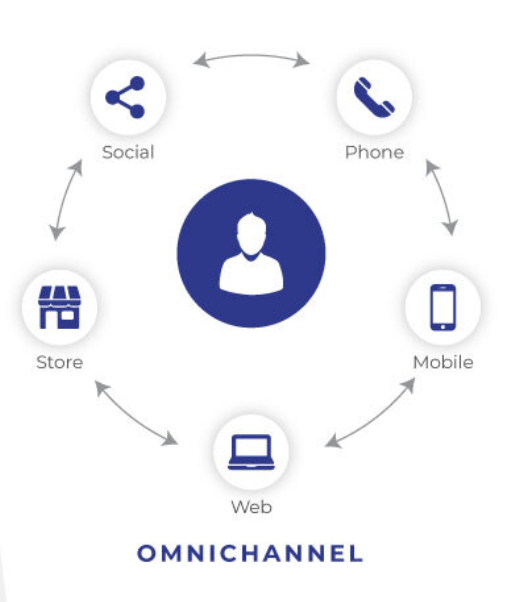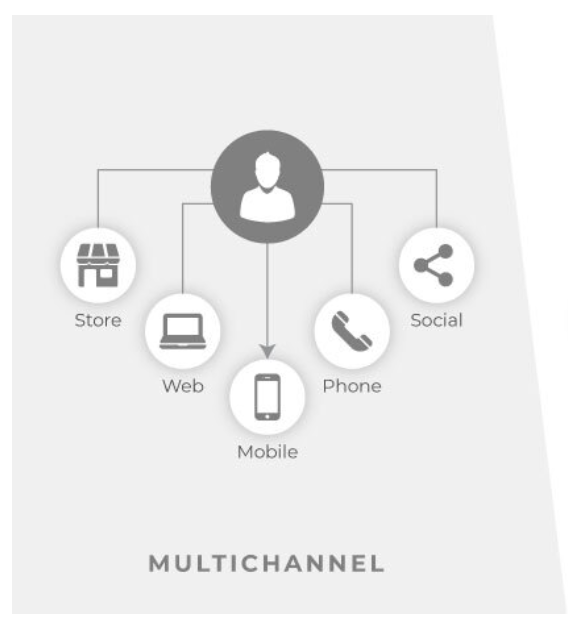Today’s customer desires the flexibility to choose when, where, and how they shop. Recognizing this shift in consumer behavior, business owners and marketing teams tussle between two popular strategies: multichannel and omnichannel ecommerce.
The two terms are often used interchangeably, as both approaches amplify marketing efforts through diverse customer touchpoints. However, there are distinct differences between the two approaches and understanding these nuances can have a significant impact on your commerce success.
What is omnichannel ecommerce?
Let’s start with an example. Consider Starbucks, a pioneer in omnichannel retail. The coffee giant allows customers to order through its mobile app, on its website, in-store, or via a drive-thru. The beauty lies in the seamless transition between these channels. A customer can order on the app and pick up the coffee in-store without missing a beat.

Source: Vinculum Group
Omnichannel ecommerce takes integration to the next level by providing a seamless and consistent experience across all channels. It's not just about having multiple channels but ensuring they work together harmoniously, creating a unified brand experience. Communication is seamless, and data and inventory management are unified, providing businesses with a holistic view of their operations. It’s a customer-centric strategy, focusing on each customer’s preferences and satisfaction.
What is multichannel ecommerce?
Imagine you're introducing a new product to the market, and your goal is to create buzz and anticipation. To kick off this journey, you could initiate a promotional campaign, highlighting the unique features, advantages, and anticipated launch date. This involves reaching out to your audience through various channels, such as social media platforms and email newsletters, ensuring that your message resonates with both your social media followers and those subscribed to your email updates. This multi-channel approach maximizes visibility and engages your audience across different platforms, building anticipation and setting the stage for a successful product launch.

Source: Vinculum Group
So, multichannel ecommerce involves selling products or services through multiple independent channels. These channels include a website, physical stores, social media platforms, and 3P marketplaces. The objective of this strategy is to reach a broad audience for quick revenue generation. Multichannel ecommerce offers diverse sales channels, enabling businesses to tap into different customer segments.
Key differences between omnichannel and multichannel ecommerce
In both multichannel and omnichannel, the idea is to sell through many different types of stores, both in-person and online. Where they differ is that an omnichannel strategy ensures the customer experience is well-coordinated across various touchpoints. This small, yet key difference has a significant impact on results. Consumers want a seamless, connected experience – this is something only an omnichannel strategy can deliver.
Understanding the subtle distinctions between these two strategies can help you realize the value of going omnichannel.
- 1. Focus on sales objectives
Multichannel commerce directs its efforts toward expanding into new channels with a primary emphasis on achieving sales objectives and tapping into new customer bases. In contrast, omnichannel commerce prioritizes providing a cohesive and integrated customer experience across various channels, aiming to engage customers at different stages of their journey rather than solely focusing on sales metrics.
- 2. Brand consistency in B2B commerce
Within multichannel ecommerce, brand representation is left at the discretion of the channel, evident when a B2B business extends its presence to platforms like Amazon. On the other hand, omnichannel strategies ensure increased brand consistency across channels in B2B commerce, maintaining a uniform and recognizable brand image throughout various touchpoints.
- 3. Personalization as a cornerstone
Multichannel commerce may not put as much emphasis on personalization, focusing more on the efficient execution of sales through diverse channels. In contrast, omnichannel commerce revolves around personalization, leveraging customer insights across channels to provide a tailored and individualized online shopping experience.
- 4. Resources and technology
Multichannel engagement involves interacting with users across various channels, but may not seamlessly synchronize data. In omnichannel commerce, resources and technology are strategically employed to engage users seamlessly across channels, fostering a connected and integrated shopping experience that extends beyond individual touchpoints.
This table provides a concise overview of the key distinctions between omnichannel and multichannel ecommerce in various aspects.
| Aspect | Omnichannel ecommerce | Multichannel ecommerce |
|---|---|---|
| Customer experience | Consistent and personalized across all channels | Varies across different channels |
| Channel integration | Channels interconnected for seamless transitions | Independent channels operating separately |
| Communication | Unified communication across channels | Siloed communication in each channel |
| Inventory management | Centralized system for efficient management | Decentralized systems for each channel |
| Order management | Unified order processing for streamlined fulfillment | Channel-specific order processing |
| Flexibility | Adaptable to customer preferences and behavior | Limited adaptability, lacks personalization |
Considerations for a successful omnichannel approach
Now that you’ve learned the specific elements of an omnichannel approach, it’s important to take the appropriate steps when setting up this ecommerce strategy. Consider the following factors when going omnichannel:
- Evaluate business goals and customer expectations
Begin by clearly understanding your business goals and objectives. Consider what you want to achieve through your omnichannel strategy. Simultaneously, assess the expectations and preferences of your target customers. A strategy aligned with both business goals and customer expectations will pave the way for success.
- Technology requirements and investment considerations
Assess the technology infrastructure required for an omnichannel strategy. Consider the costs associated with implementing and maintaining the necessary tools and systems. Factor in the long-term investment required to ensure that the strategy aligns with your budget and technological capabilities.
- Staff training and organizational changes
Recognize the importance of staff training and potential organizational changes. Omnichannel strategies may necessitate a shift in how teams collaborate and share information. Ensure that your staff is equipped with the skills needed to manage the strategy effectively and that organizational structures support the approach.
- Market dynamics and industry trends
Stay informed about market dynamics and industry trends. Understand how consumer behavior is evolving and how your competitors are adapting to changing trends. An omnichannel strategy aligned with current market dynamics ensures your business remains competitive and can capitalize on emerging opportunities.
- Flexibility for innovation and growth
The ecommerce landscape is dynamic, and an omnichannel approach should accommodate future changes and technological advancements. Creating room for adaptation ensures your business stays relevant and can evolve with the ever-changing digital landscape.
And there you have it - the fog has lifted on the long-standing omnichannel vs. multichannel debacle. With clarity around their unique differences, it’s easier to see how implementing an omnichannel strategy ensures a seamless journey everywhere your customers go. Every touchpoint becomes a chance to deepen the relationship, offering customers consistent and personalized experiences. You have to understand their preferences, anticipate their needs, and make them feel seen at every step. By embracing this holistic approach, you not only sell more products but you also create a narrative that keeps customers coming back for more.
Ready to go omnichannel, but not sure where to start? Discover how Product-to-Consumer (P2C) Management can condense your operations to simplify omnichannel processes.


